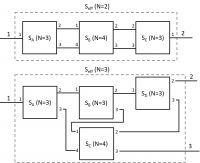mtwieg
Advanced Member level 6
I'm wondering if there's a generalized way to derive the total S matrix for a combination of networks with arbitrary numbers of ports? Like for the following two examples, how to derive the overall Seff:

I'm familiar with T and ABCD parameters for cascading 2 port networks, but can't find any extension to more ports. Maybe something like Mason's rule is the correct approach...

I'm familiar with T and ABCD parameters for cascading 2 port networks, but can't find any extension to more ports. Maybe something like Mason's rule is the correct approach...